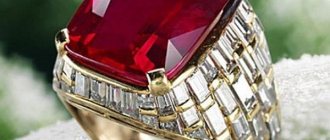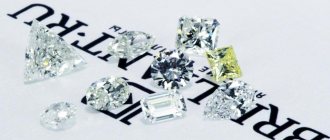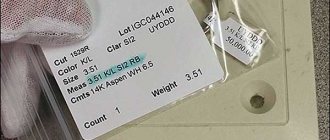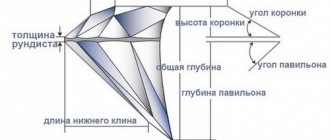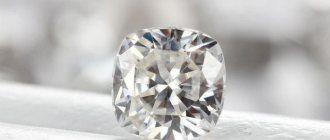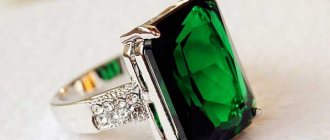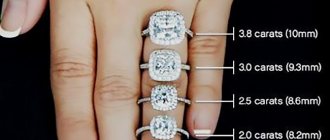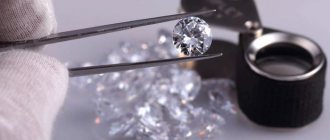It is impossible to determine the exact number of facets a diamond has, because their presence will be determined by the size and shape of the precious mineral.
A stone can have from 2 to 102 falsettos; a cut of 57 falsettos is considered classic, that is, a diamond has 57 facets and a circle shape. Such crystals are considered ideal because they have amazing brilliance. However, we should not forget about other processing methods.
A little history
A diamond is not distinguished by its brilliance and in this parameter is significantly inferior to a diamond. It is not surprising that until stones were learned to be processed, they were not in great demand.
The situation changed radically when one of the court jewelers came up with the idea of working a little with the diamond. He subjected it to processing, the master created only a few faces and presented the result of the work to the king. This happened in the 16th century, since then diamonds have become rare and expensive, they began to be perceived as a symbol of power and prosperity.
Initially, they used a rose-shaped cut: jewelers created only a few facets by polishing the diamond a little. However, this was enough for the stone to begin to sparkle.
Today, this form of processing is considered obsolete, but crystals are still cut in this way, since “rose” has two significant advantages: it is easy to perform and allows you to minimize costs.
During processing, the mineral loses from 35 to 70% of its original mass. If the stone is rare and expensive, then a complex cut can significantly reduce its weight - for this reason, a jeweler may use a rose-shaped cut.
Despite the fact that diamonds began to be processed a long time ago, jewelers did not immediately achieve significant success in this matter.
In 1919, mathematician Marcel Tolkowsky was able to calculate the ideal proportions of diamonds. It is worth noting that back in the 17th century there was a cut similar to diamond or classic, but this method of processing crystals was far from ideal.
Thanks to the calculations of Marcel Tolkowsky, it was possible to create a cut in which light entered the stone through the crown, it was refracted from the faces that were located below. As a result, the light began to play with rays, a “rainbow” was created. This was the so-called ideal cut of 57 falsettos, which is still used today.
Today, there are several forms of diamond processing; the cutting method largely depends on the size of the stone and the presence of defects in its structure.
Diamond clarity rating
Unlike synthetics, natural stones are imperfect. They always have flaws such as cracks or inclusions.
What is meant by the term “purity”
Purity is a quality that shows how many and what kind of inclusions are present in the stone (or records their absence). Such defects can be internal (impregnations) or superficial (spots). There are coal or snow inclusions. Most often these are dark particles of magnetite or ilmenite, less often reddish garnet, brownish spinel or greenish malacolite. The degree of purity of the stone depends on their number, location and dimensions.
The final weight and level of cut of the diamonds are determined by the master, but he cannot always change the clarity. This refers to factors that spoil the appearance of a diamond, but cannot be eliminated without noticeable loss of weight or size.
Diamond Clarity
The class of this characteristic shows how deeply the light will penetrate the pebble. The higher the level of purity, the more it “forces” the light to refract, reflecting on the edges and creating signature shimmers.
Diamond clarity (sometimes the term "clarity" is used) is determined using a 10x loupe - this is a worldwide practice.
There are no flaw-free diamonds. Transparent stones, devoid of internal inclusions, are considered ideal: the external ones are removed by polishing or ideally cut. However, if there are “strangers”, then the crystal was created by nature.
Russian scale
According to the Russian method, the diamond clarity scale has a different basis - during distribution, the mass of crystals is measured and the number of faces is taken into account:
- small stones with 17 facets - six categories of purity;
- with 57 facets, not heavier than 0.299 carats – 9 categories;
- with 57 facets, from 0.300 carats – 12.
Assessing the clarity of a diamond The higher the category number, the worse the quality of the mineral. The best degree of purity is for stones of the first category in all classifications. These are minerals without fracturing, foreign fragments or other flaws. They are counted in units and cost exorbitantly.
GIA Score
The system distributes stones into 11 classes. Importance is given to the dimensions, quantity and degree of distinguishability of internal and external inclusions. The carat and cut of the stone are not taken into account:
| Designation | Class | Characteristic | |
| 1 | Flawless | F | Ideal |
| 2 | Internally Flawless | IF | Almost ideal |
| 3 | Very Very Small Inclusions | VVS 1, VVS | Very, very small inclusions (one or two - indicated by the number) |
| 4 | Very Small Inclusions | VS 1, VS 2 | Very small inclusions (one or two - indicated by the number) |
| 5 | Small Inclusions | SI 1, SI | Small inclusions |
| 6 | Imperfect | I 1, I 2, I | Far from perfect example |
Correlation of purity scale indicators
Product tags indicate data on different scales. The following table will help you avoid confusion and correctly determine cleanliness:
| GIA | Russian system (cut, carat) | Description (valid options) | ||
| Up to 0.299 | From 0.300 | |||
| Kr - 17 | Kr - 57 | Kr - 17 | ||
| F | 1 | 1 | 1 | No defects found. |
| IF | 2 | 2 | 2 | One or two light dots in the center or on the periphery or a stripe (acceptable). |
| VVS 1, VVS 2 | — | 3 | 3 | A maximum of three light dots or one or two barely visible dots or lines of dark shades. |
| — | — | — | 4 | Dark dots - one or two, almost invisible, concentrated in depth, or light dots - small, up to four, any segment of the stone, a small surface crack is acceptable. |
| VS 1 | 3 | 4 | 5 | A small crack or light haze in depth, up to six light dotted or striped fragments or up to three dark dotted inclusions. |
| VS 2 | — | 5 | 6 | No more than one graphite inclusion, up to eight bubbles, stripes, light-colored dots, cracks; up to five dark dot fragments. |
| SI 1, SI 2 | — | — | 7, 7a | Graphite haze, no more than two single inclusions of graphite, up to eight small flaws in total. |
| SI 3 | 4 | 6 | 8 | Many minor defects, some of which are barely visible under a magnifying glass. |
| I 1 | — | — | 9 | Cracks are sometimes accompanied by inclusions or visible to the naked eye. |
| I 2 | — | 7 | 10 | Multiple defects, transparency at least 60%. |
| I 3 | 5 | 8 | 11 | Numerous flaws, transparency 30-60%. |
| — | 6 | 9 | 12 | Numerous flaws, transparency up to 30%. |
The visibility of flaws with the naked eye (without a magnifying glass) depends on the size of the stone: on minerals up to 0.299 they are visible starting from purity level 6, on specimens heavier than 0.300 - from 7. These data should be taken into account when purchasing stones.
Other processing methods
There are several ways to cut diamonds. To make a diamond beautiful and shiny, a jeweler can use:
- Step cut.
- Modified.
- Mixed.
The step cut is considered one of the oldest. Pebbles that have the shape of a rectangle, triangle and trapezoid are processed in this way. The edges of the crystal are located parallel to the girdle - this type of processing will help hide the defects of the diamond and emphasize the color of the stone and its transparency. Often used when working with fancy diamonds.
The next type of stone processing is quite good; it helps to create high-quality diamonds; in terms of characteristics (transparency and brilliance), they can be on par with those crystals that have 57 falsettoes. A modified cut allows you to modify the stone and give it different shapes. At the same time, it is possible to maintain the number of faces and their location.
The mixed type of processing has a number of advantages: it helps to reduce costs during the work process, as well as add shine to the stone. Jewelers claim that this type of processing combines the advantages of step and diamond cutting. Such stones are currently in demand. For the first time, a mineral processed in this way was presented to the public in the 60s of the 19th century.
There is also an emerald cut. It allows you to visually increase the size of the stone. However, crystals are rarely processed in this way; they have the shape of a rectangle or square.
There is also “Russian cut” - this term originated during the USSR, but is still used today. The jewelers of the Soviet Union never came up with anything new, for this reason the term remained as a brand.
In the second half of the 20th century, jewelers created more sophisticated methods for processing diamonds. They are mainly used for cutting large diamonds weighing more than 1 carat:
- “Highlight-Cat” implies the creation of 73 falsettos, with 41 edges located on top and 32 below.
- “Royal cut” has 86 facets, with 49 facets located at the top and 37 at the bottom.
- A “majestic cut” of 102 falsettos implies the presence of 61 facets at the top and 41 at the bottom.
When evaluating a diamond, jewelers use the “4 C” system - it allows you to fully characterize the stone and determine its value. Cut is also taken into account when assessing the quality of a crystal.
This concept is considered subjective, since it can affect the cost of the mineral, but when evaluating a stone, not only the processing method, but also other criteria are taken into account.
There are several forms of processing that are considered common and occur quite often, among them are:
- "Marquis" with 55 falsettos.
- "Emerald" with 65 facets.
- "Oval" with 57 falsettos.
- "Triangle" with 52 sides.
- "Heart" with 57 falsettos.
- "Square" with 33 sides.
- "Baguette" with 25 and 33 falsettos.
All these processing methods are called fantasy; they are less common. The “baguette” is considered unique and is worth considering in more detail. “Baguette” is used when working with small diamonds. The quality of processing is checked in accordance with compliance with several criteria: determination of proportion and quality of symmetry.
In the classic variation, the diamond has 57 facets and a circle shape. But crystals of a different shape with fewer facets cannot be called less beautiful, since they also sparkle spectacularly in the sun and cause envy among others.
What is a diamond cut
Diamond cutting is an important and necessary process of transforming a diamond into a luxurious gem. An uncut crystal cannot be inserted into a piece of jewelry; it will not have a luxurious appearance and magnificent shine.
A cutter transforms rough diamonds into diamonds by directly impacting them with special tools. All processing stages are carried out manually. This is a long and painstaking process requiring:
- precision of movements;
- perseverance;
- ability to imagine three-dimensional images of future products.
How many faces do diamonds have?
Oval cut
Anyone who has ever looked at a diamond has wondered how many facets a diamond has. The archives preserve the date of 1465, when a diamond was cut into 24 facets for the first time in Burgundy. Until this time, gems were only ground and polished. At the beginning of the last century, the mathematician Tolkovsky calculated the optimal number and shape of edges when a ray, refracted inside the stone, creates a rainbow shine. This tag of 57 sides was called “Russian”; its structure became classic.
Distinctive Features of a Rough Diamond and a Diamond
One carat of uncut diamond is relatively inexpensive, around $100. But the cost of a diamond made from it will be several times higher.
The price may be affected by the type of cut that was given to the stone after processing. It can be round and fancy. Oblong diamonds take the shape of a marquise, a drop or a pear, an oval and a heart.
Transforming a rough diamond into a rounded diamond is a rather long and labor-intensive process that requires very careful attention to maintaining all proportions. This, in particular, determines the high cost of the diamond.
Diamond
Diamond has various properties. It is an indispensable material for jewelry production and other industries. Diamond conducts heat very well, cuts glass and is wetted by fats, so the marker is able to leave a solid line on the surface of the diamond, unlike fakes, where it blurs.
Diamond
The authenticity of a diamond is determined by a rudinist, who divides it into top and bottom. It doesn't have to be transparent. Matteness is a sign of a real stone. A real diamond has sparkle, but not as much as moissanite. The printed text directly underneath cannot be seen through the diamond, unlike with fakes.
A real diamond will glow when exposed to ultraviolet light. And, of course, the facets of a real diamond are very difficult to damage.
An uncut crystal does not have a high cost, which should be taken into account when purchasing jewelry. Fraudsters often use the name “diamond” itself, causing uncomprehending buyers to spend large sums on purchasing an almost fake.
